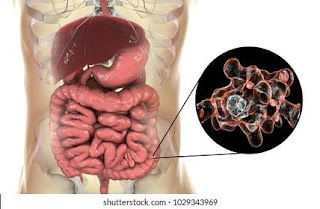Amebiasis is a parasitic infection of the intestines caused by the protozoan Entamoeba histolytica, or E. histolytica. The symptoms of amebiasis include loose stool, abdominal cramping, and stomach pain. However, most people with amebiasis won’t experience significant symptoms.
Who is at risk for amebiasis?
Amebiasis is common in tropical countries with underdeveloped sanitation. It’s most common in the Indian subcontinent, parts of Central and South America, and parts of Africa. It’s relatively rare in the United States.
People with the greatest risk for amebiasis include:
•people who have traveled to tropical locations where there’s poor sanitation
•immigrants from tropical countries with poor sanitary conditions
•people who live in institutions with poor sanitary conditions, such as prisons
•men who have sex with other men
•people with compromised immune systems and other health conditions
What causes amebiasis?
E. histolytica is a single-celled protozoan that usually enters the human body when a person ingests cysts through food or water. It can also enter the body through direct contact with fecal matter.
The cysts are a relatively inactive form of the parasite that can live for several months in the soil or environment where they were deposited in feces. The microscopic cysts are present in soil, fertilizer, or water that’s been contaminated with infected feces. Food handlers may transmit the cysts while preparing or handling food. Transmission is also possible during anal sex, oral-anal sex, and colonic irrigation.
When cysts enter the body, they lodge in the digestive tract. They then release an invasive, active form of the parasite called a trophozite. The parasites reproduce in the digestive tract and migrate to the large intestine. There, they can burrow into the intestinal wall or the colon. This causes bloody diarrhea, colitis, and tissue destruction. The infected person can then spread the disease by releasing new cysts into the environment through infected feces.
What are the symptoms of amebiasis?
When symptoms occur, they tend to appear 1 to 4 weeks after ingestion of the cysts. According to the Centers for Disease Control and PreventionTrusted Source (CDC), only about 10 to 20 percent of people who have amebiasis become ill from it. Symptoms at this stage tend to be mild and include loose stools and stomach cramping.
Once the trophozites have breached the intestinal walls, they can enter the bloodstream and travel to various internal organs. They can end up in your liver, heart, lungs, brain, or other organs. If trophozites invade an internal organ, they can potentially cause:
•abscesses
•infections
•severe illness
•death
If the parasite invades the lining of your intestine, it can cause amebic dysentery. Amebic dysentery is a more dangerous form of amebiasis with frequent watery and bloody stools and severe stomach cramping.
The liver is a frequent destination for the parasite. Symptoms of amebic liver disease include fever and tenderness in the upper-right part of your abdomen.
How is amebiasis diagnosed?
A doctor may suspect amebiasis after asking about your recent health and travel history. Your doctor may test you for the presence of E. histolytica. You may have to give stool samples for several days to screen for the presence of cysts. Your doctor may order lab tests to check liver function to help determine if the ameba has damaged your liver.
When the parasites spread outside the intestine, they may no longer show up in stool. So your doctor may order an ultrasound or CT scan to check for lesions on your liver. If lesions appear, your doctor may need to perform a needle aspiration to see if the liver has any abscesses. An abscess in the liver is a serious consequence of amebiasis.
Finally, a colonoscopy may be necessary to check for the presence of the parasite in your large intestine (colon).
What treatments are available for amebiasis?
Treatment for uncomplicated cases of amebiasis generally consists of a 10-day course of metronidazole (Flagyl) that you take as a capsule. Your doctor may also prescribe medication to control nausea if you need it.
If the parasite is present in your intestinal tissues, the treatment must address not only the organism but also any damage to your infected organs. Surgery may be necessary if the colon or peritoneal tissues have perforations.
What is the outlook for people with amebiasis?
Amebiasis generally responds well to treatment and should clear up in about 2 weeks. If you have a more serious case where the parasite appears in your internal tissues or organs, your outlook is still good as long as you get appropriate medical treatment. If amebiasis is left untreated, however, it can be deadly.
How can I prevent amebiasis?
Proper sanitation is the key to avoiding amebiasis. As a general rule, thoroughly wash hands with soap and water after using the bathroom and before handling food.
If you’re traveling to places where the infection is common, follow this regimen when preparing and eating food:
•Thoroughly wash fruits and vegetables before eating.
•Avoid eating fruits or vegetables unless you wash and peel them yourself.
•Stick to bottled water and soft drinks.
•If you must drink water, boil it or treat it with iodine.
•Avoid ice cubes or fountain drinks.
•Avoid milk, cheese, or other unpasteurized dairy products.
•Avoid food sold by street vendors.















